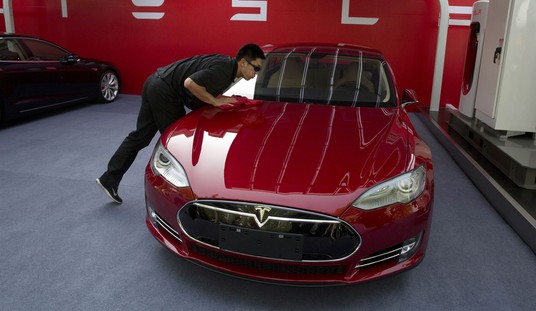Last month, the Bureau of Economic Analysis released the advance estimate of the gross domestic product for the second quarter of 2013 as well as the 14th comprehensive revision of the prior estimates of GDP going all the way back to 1929. The comprehensive revision is a rather remarkable story, but with the fresh release of second of three revisions, that will have to wait just a bit.
Back then, the BEA estimated the annualized, seasonally-adjusted GDP growth for the second quarter at +1.7%. The second of three scheduled estimates came in at a +2.5% annualized growth:
Real gross domestic product — the output of goods and services produced by labor and property located in the United States — increased at an annual rate of 2.5 percent in the second quarter of 2013 (that is, from the first quarter to the second quarter), according to the “second” estimate released by the Bureau of Economic Analysis. In the first quarter, real GDP increased 1.1 percent.
The GDP estimate released today is based on more complete source data than were available for the “advance” estimate issued last month. In the advance estimate, the increase in real GDP was 1.7 percent. With this second estimate for the second quarter, the increase in exports was larger than previously estimated, and the increase in imports was smaller than previously estimated.
The increase in real GDP in the second quarter primarily reflected positive contributions from personal consumption expenditures (PCE), exports, private inventory investment, nonresidential fixed investment, and residential fixed investment that were partly offset by a negative contribution from federal government spending. Imports, which are a subtraction in the calculation of GDP, increased.
The acceleration in real GDP in the second quarter primarily reflected upturns in exports and in nonresidential fixed investment and a smaller decrease in federal government spending that were partly offset by an acceleration in imports and decelerations in private inventory investment and in PCE.
The economic experts were anticipating an increase to 2.2% on the strength of June exports. Reuters was mostly enthused by this better-than-expected good news:
The U.S. economy accelerated more quickly than expected in the second quarter thanks to a surge in exports, bolstering the case for the Federal Reserve to wind down a major economic stimulus program.
Gross domestic product grew at a 2.5 percent annual rate, according to revised estimates for the period that were released by the Commerce Department on Thursday. The quarter’s growth rate was more than double the pace clocked in the prior three months.
The report could boost confidence that the economy is turning a corner despite government austerity measures. At the same time, a full recovery from the 2007-09 recession is probably years away as the U.S. jobless rate remains historically high at 7.4 percent.
Reuters noted that investments in housing accounted for about a fifth of that GDP growth, but cautioned that higher interest rates caused by fear that the Federal Reserve would begin to slow down its bond-buying program could reverse that trend in a hurry. They did, however, miss the fact that the change in private inventories also accounted for a fifth of that GDP growth.
Highlights of the comprehensive revisions:
To honor the addition of the costs of producing movies and various other literary and artistic works, as well as the amount spent on research and development, on the positive side of GDP, here are “The Good, the Bad, and the Ugly” highlights (or lowlights as the case may be) from the comprehensive revisions:
The Good: The nominal (current-dollar) estimate of GDP in the first quarter of 2013 jumped from $15.984 trillion to $16.535 trillion based on the comprehensive revisions.
The Bad: Several of the previous quarters saw rather radical decreases in the increase in real (constant-dollar, now benchmarked to 2009 instead of 2005) GDP:
- First quarter 2013 real GDP growth shrank from +1.8% to +1.1%.
- Fourth quarter 2012 real GDP growth shrank from +0.4% to +0.1%.
- Second quarter 2012 real GDP growth turned into real GDP shrinkage, as it went from +0.1% to -1.3%.
The Ugly: Taxing the “rich” is even more destructive than previously thought. Tom Blumer put together a chart comparing the first 4 years of the Reagan recovery from the 1981/1982 recession to the first 4 years of the Obama “recovery” from the Great Recession (using last month’s preliminary read of the 2Q2013 GDP), and it’s not pretty.
Related to that, The Wall Street Journal took a more-expansive look at the comprehensive revision:
We also learn from the revisions that the stagflationary 1970s—in particular the Nixon years—generated even less growth than originally recorded. This was an era of the 70% top marginal tax rate made worse by inflation that hit 13% and a huge expansion of the welfare and regulatory state.
By contrast, growth in the 1980s was even faster than we thought, averaging 4.4% a year from 1983-1989. This was the era by and large of tax cuts, deregulation, disinflation and government spending restraint. The recession of 1990, portrayed as a catastrophe at the time, turns out to have been minuscule, as the Reagan boom flowed into the prosperity of the 1990s. The Clinton tax increase of 1993 slowed growth from the robust recovery of late 1992 (3.6% for the year), but the Clinton-Gingrich policy mix and stalemate let the private information economy expand.
… the economy grew faster in the five years following the 2003 investment tax cut than previously measured. The five-year average was 3%, and over 2004-2005 growth averaged a robust 3.6%. The housing bust and financial panic ruined what was otherwise an economy growing at close to post-1929 norms.
The “Intellectual Property” factor:
The biggest boost in nominal GDP through the comprehensive revisions came from the BEA recognizing the expenditures in research and development and in most forms of original artistic works as fixed investment. Specifically with respect to the $559.8 billion increase in 2012 annual nominal GDP, R&D provided $396.7 billion (including $269.1 billion in privately-funded R&D) of that increase, while artistic works provided $74.3 billion of that increase.
The BEA describes why it is now considering R&D spending as investment in its FAQ on the change, “R&D has long been recognized as having the distinguishing features of fixed assets: it is a produced asset using labor and capital resources; it has defined ownership rights; it is used repeatedly in the production process; and it has a useful life of more than one year.” The BEA further went on to explain that research that leads to nothing is functionally no different than drilling an unsuccessful oil well or purchasing equipment that is faulty or prematurely scrapped.
As for the inclusion of artistic originals that are mass-produced, at first blush it does seem nothing more than a gift to Hollywood. Upon further reflection, the production of an artistic original is equivalent to a sprocket manufacturer buying a new die to mass-produce a new sprocket.








Join the conversation as a VIP Member